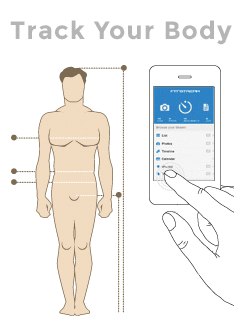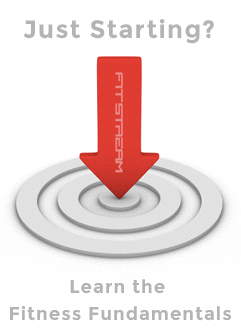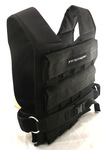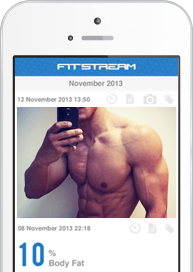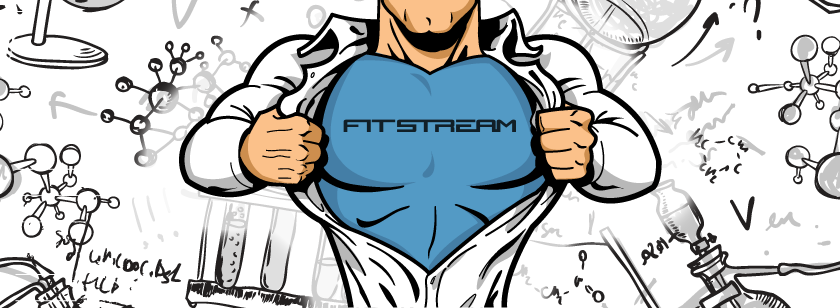
This article is a beginners’ guide to self experimentation to help build a stronger, healthier body.
Whilst there are universal principles for good health and fitness, we’re all unique and respond differently to the same training methods and diet. The smart thing to do is to fine tune the details of your lifestyle so that they work for you and your goals.
Experimenting and tracking changes in your body is an effective method of self discovery and will help transform your physique. We’ll show you how, but first of all, what exactly do we mean by self experiments?
What is self experimentation?
This is simply a loose framework you can apply to your life whereby you design small experiments and track the changes in your mind and body. The goal is to improve a certain area of your life.
Here are some example experiments;
- Cutting or adding something to your diet and the effects on muscle gain
- Getting more or less sleep and the effect on recovery
- Taking a new supplement and impact on weight loss
- Changing training methods or adding a new exercise and the effect on body composition
- Tweaking exercise intensity, duration, volume and the changes in body part sizes
- Practicing meditation and its effect on stress
- The effects of workout days on sleep quality
- Keeping a gratitude journal and its affect on mood
Why you should self experiment
What works for others might not necessarily work for you so the best way to find out about the effects of certain variables in your life is to conduct your own experiments.
A self experiment framework helps you to;
- Learn about yourself and how your body responds in different ways to different stimuli
- Create an awareness of how your lifestyle affects you so that you can make smarter decisions
- Stay accountable and focused on positive change
A framwork for self experimentation
Many people running self experiments don’t properly structure or record their results, which limits their usefulness. We have designed this step-by-step guide to running your own quantified self experiments.
Experiments are made up of two parts; the variable, which is the area of your life you’re interested in changing (e.g. improving energy levels), and the treatment, which are the actions that you do to try to create that change (e.g. get 8 hours sleep a night).
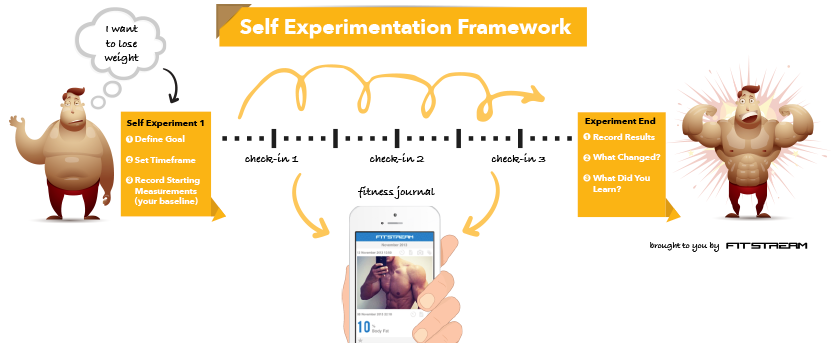
Step 1 - Determine what you're testing
We’re going to assume that you have some tests in mind, but if not, ask yourself “what is it I’m trying to achieve?” From here, you can research what factors other people have found effective for achieving similar goals and use this as inspiration for your experiment.
Once you know what you’re testing you need to distill it down into a concise statement like this - “If I do X then there will be a change in Y”. Here’s an example;
“If I get 8 hours of sleep a night then there will be a change in happiness and energy levels”
Step 2 - Figure out what you're measuring and how you'll be doing it
Depending on what you’re testing, you’ll find different approaches to measurement;
- Variables which are easy to quantify and measure such as body weight, waist size, blood sugar level, number of hours slept or protein intake. These are quantitative measurements.
- Variables which are more subjective and difficult to quantify such as sleep quality, energy levels, mood, stress level, and hunger. These are more qualitative metrics and you may like to create your own rating system to effectively quantify them. For example, at set points during the day you could measure energy levels on a 1-10 rating scale.
There are many possible variables that you could be tracking and we can't cover everything here, but the most important thing is that your measurements are taken consistently.
Whatever you’re tracking, you’re unlikely to be the first, so we’d advise you to search Google about how other professionals or researchers have tracked those variables for inspiration.
Using our example experiment - “If I get 8 hours of sleep a night then there will be a change in happiness and energy levels” here is what we’d consider measuring;
- Sleep duration
- Sleep quality
- How long it takes to get out of bed
- How long it takes you to fall asleep (latency)
- Number of times you woke up
- Energy levels at 3 hour intervals throughout the day
Some of these measurements would be best recorded on a subjective scale, e.g. 11am energy levels rated as 7 out of 10. Others, such as sleep duration or quality could be measured using a combination of sleep tracking apps and wearables to automatically track data.
Step 3 - Set your timeframe
Self experiments can last anywhere between a few days to a few weeks. It really depends on what you're testing and the amount of time you'll need to see results. For example, you may see changes in mood or sleep quality much quicker than body composition changes. As a guide, we'd suggest;
- Body composition experiments (e.g. weight loss, muscle building etc) are measured over a one month period at minimum
- Sleep, mood, energy level experiments at one to two weeks
- More complicated variables such as gut flora changes may require much longer timeframes upwards of one month
Now that you know what you're testing, how you'll be measuring, and how long for it's time to start your experiment!
Step 4 - Establish your baseline
Before you start your experiment and tweak your lifestyle it’s important to establish your baseline, that is, a picture of your data before the experiment starts. This is important so that you have data to compare against your actual test results and is called an A / B Test.
Phase A, is the ‘baseline’, and represents your current lifestyle. In our energy levels example, you’d record the metrics we detailed in Step Two under your normal conditions, before you make any lifestyle changes.
Phase B, is the Test Phase where you actually make the changes to your variables (in this case to get more sleep!).
Run Phase A for the same duration of time as the main experiments and record those measurements.
Step 5 - Run the Test Phase!
It’s now time to run Phase B, the Test Phase and record your next batch of measurements to see how they’re affected. Dedication and consistency are key here.
You must stay disciplined and make the changes to your lifestyle, which is often easier than it sounds as you’ll be fighting ingrained habits. Do everything you can to build the new habit into your routine, whether that’s setting reminders, leaving messages on your mirror or throwing out all those snacks to avoid temptation!
Optional A/B/A Test: Now you’ve recorded results for the A Phase (your baseline), and B Phase (the treatment phase), you may consider repeating a second A Phase by reverting back to original habits. This will show you how it affects your variables before and after your changes and how long any effects last.
Recording your results
In order to track your body and record results we highly encourage you to keep a fitness journal.Fitstream have built the ultimate platform for journaling your fitness progress. You can track body measurements, notes or progress pictures quickly and easily using our free journaling app.
Step 6 - Analyze your data
Using our example of improving energy levels and mapping these to a ten-point scale (1 being very low energy and 10 being bouncing off the walls) it's easy to plot the data on a chart like the example below;
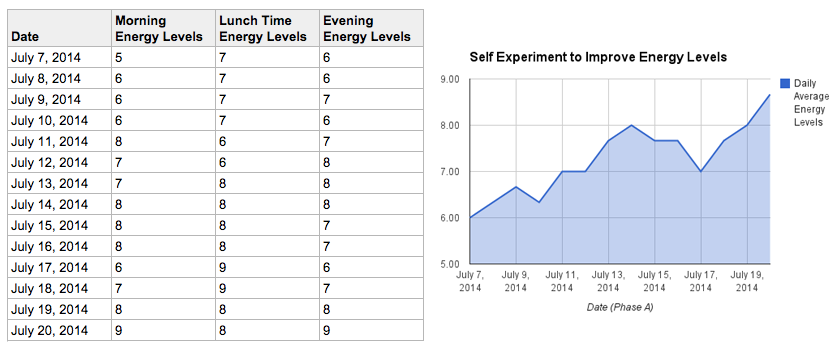
Compare your Phase A and B data sets and hopefully you will be able to spot changes in the data and identify any trends quite easily. Here are some things to look out for or questions to ask yourself;
- What are the highest and lowest values?
- Calculate average values for each phase
- Are there any trends or increases / decreases in measurements
- Where there are spikes or troughs in the data, consider what was different about that particular day
Share your results
We hope you've found this guide useful and that you'll go forward with your own self experiments that help to transform your health and body. We'd really like to hear about your results too, so reach out to us on Facebook, Twitter, or on email at admin@fitstream.com to share your stories.
We hop you consider using Fitstream to journal your progress and we'd love it if you shared your progress publically with the community. This helps to inspire others with their own experiments or someone might even be able to help interpret your data and findings for you.
Happy experimenting!

